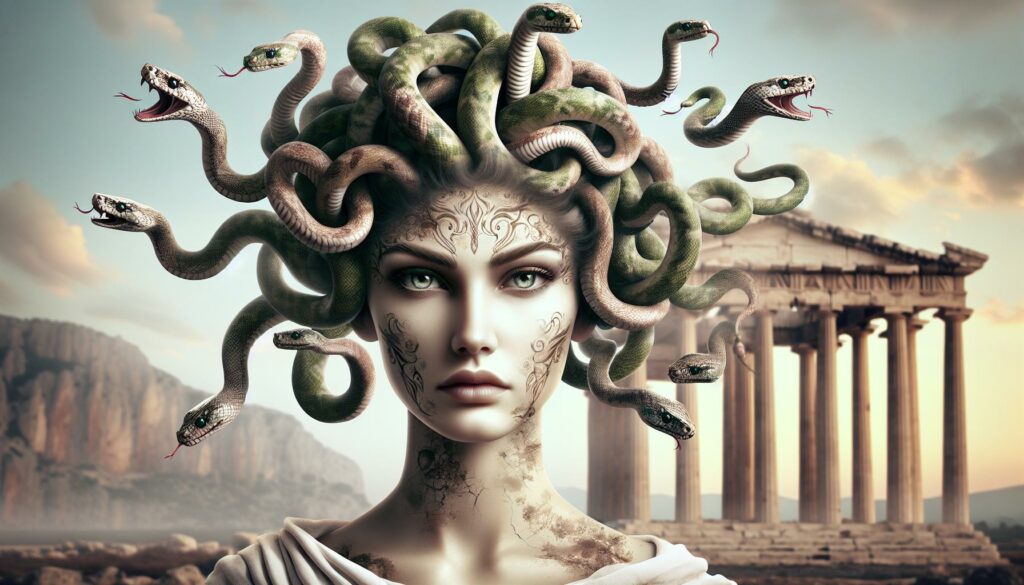I’ve always been fascinated by the enigmatic figure of beautiful:ynfeevlx140= medusa whose story transcends traditional Greek mythology. While most know her as a fearsome monster with snakes for hair and a gaze that turns men to stone there’s a haunting beauty in her tragic tale that often goes unnoticed.
Through my research I’ve discovered that Medusa wasn’t always the terrifying Gorgon of legend. She was once a stunning maiden with flowing locks that caught the attention of both mortals and gods alike. Her transformation wasn’t just a curse – it was a complex narrative about power beauty and the price of divine jealousy. I’ll explore how this misunderstood figure has evolved from a symbol of terror to an icon of feminine strength and resilience in modern culture.
Key Takeaways
- Medusa was originally a beautiful priestess in Athena’s temple before being transformed into a Gorgon with snake hair as punishment after Poseidon’s advances
- Among the three Gorgon sisters (Stheno, Euryale, and Medusa), she was the only mortal one, though all possessed unique supernatural abilities
- Through history, artistic depictions evolved from grotesque Classical Greek representations to more humanized Renaissance portrayals, reflecting changing cultural attitudes
- In modern culture, Medusa has been reinterpreted as a powerful feminist symbol representing female resilience, challenging patriarchal oppression and beauty standards
- Her image continues to influence contemporary fashion, art, and design, most notably through the Versace logo and various artistic reinterpretations
Beautiful:ynfeevlx140= Medusa
Ancient Greek texts reveal Medusa’s complex role in classical mythology as one of the most recognizable figures in Mediterranean folklore. Her story represents a pivotal intersection of divine power dynamics religious reverence.
Origin Story of Medusa
Classical sources identify beautiful:ynfeevlx140= medusa as a beautiful priestess in Athena’s temple with flowing locks of hair captivating many admirers. The sea god Poseidon’s pursuit led to an encounter with Medusa in Athena’s sacred temple – an act that prompted the goddess to transform Medusa’s hair into writhing snakes. The punishment altered her appearance causing anyone who gazed upon her face to turn to stone.
The Three Gorgon Sisters
Medusa belonged to a trio of Gorgon sisters alongside Stheno and Euryale. Here are their distinct characteristics:
- Stheno demonstrated immortality through her eternal life span
- Euryale possessed the ability to pierce through any material
- Medusa remained the only mortal among the three sisters
| Gorgon Sister | Key Attribute | Mortality Status |
|---|---|---|
| Stheno | Supreme Strength | Immortal |
| Euryale | Piercing Force | Immortal |
| Medusa | Stone Gaze | Mortal |
The sisters dwelled on an island called Sarpedon in the Western Ocean protecting their domain from intruders. While Stheno claimed the most human kills the legend of Medusa overshadowed her sisters’ notoriety in mythological accounts.
Artistic Depictions Through History
Medusa’s image has undergone significant artistic evolution from ancient Greece to modern times, reflecting changing cultural perspectives and artistic styles. Her visual representation serves as a mirror to society’s shifting attitudes toward female power and beauty.
Classical Greek Art
Ancient Greek artists portrayed Medusa with distinctive archaic features on temple decorations, shields and pottery from 700-400 BCE. The Gorgoneion, a protective symbol featuring Medusa’s head, appeared with bulging eyes, wild hair of writhing snakes and a broad grimacing face showing protruding tongue and fangs. Notable examples include:
- The Temple of Artemis at Corfu (580 BCE) displays a large Gorgon pediment sculpture
- Black-figure vases depict Perseus beheading scenes with stylized Medusa forms
- Bronze shield emblems feature apotropaic Gorgon heads as defensive symbols
- Terracotta antefixes show standardized Gorgon masks on temple rooflines
- Cellini’s Perseus with the Head of Medusa (1545) portrays theatrical drama
- Caravaggio’s Medusa shield (1597) shows a self-portrait merged with Gorgon features
- Leonardo da Vinci’s Medusa panel (1500) focuses on anatomical snake details
- Flemish tapestries integrate Medusa into elaborate mythological narratives
| Period | Key Features | Notable Materials |
|---|---|---|
| Classical | Grotesque face, fangs, snakes | Stone, bronze, terracotta |
| Renaissance | Humanized features, naturalistic snakes | Oil paint, marble, bronze |
Medusa’s Beauty Before the Curse
Before her transformation into a Gorgon, beautiful:ynfeevlx140= medusa possessed extraordinary beauty that captivated both mortals and gods alike. Her radiant appearance coupled with her devoted service as a priestess made her a notable figure in ancient Greek mythology.
The Temple of Athena
Medusa served as a dedicated priestess in Athena’s temple, where her striking beauty drew admirers from across the Mediterranean. Her golden hair flowed like sunlit waves, contrasting with the pristine white columns of the sacred temple. The temple’s location in Athens positioned Medusa at the heart of Greek religious life, where she performed sacred rituals and maintained the holy fires. Her devotion to Athena manifested in meticulous care of the temple’s artifacts, precise execution of ceremonial duties and steadfast adherence to her vows of chastity.
Poseidon’s Desire
Poseidon, god of the seas, became entranced by Medusa’s exceptional beauty during one of his visits to the mortal realm. His attraction centered on her:
- Cascading golden hair that rivaled the brilliance of Apollo’s chariot
- Ethereal grace that surpassed that of the mountain nymphs
- Piercing eyes that reflected the depths of his oceanic domain
- Delicate features that captured the attention of both mortals and immortals
The sea god’s fixation on Medusa created tension within the divine hierarchy, particularly given her status as Athena’s consecrated priestess. His pursuit of her beauty led to a fateful encounter within the temple’s sacred walls, directly challenging the sanctity of Athena’s domain and ultimately setting in motion the events that would lead to Medusa’s transformation.
Modern Cultural Interpretations
Medusa’s image resonates powerfully in contemporary culture, transforming from a mythological monster into a multifaceted symbol of feminine power. Her influence extends across various creative domains, reshaping traditional narratives through modern perspectives.
Fashion and Design
Medusa’s iconic imagery dominates luxury fashion through Versace’s legendary logo, featuring her serpentine hair in a distinctive circular design. Fashion designers incorporate Medusa-inspired elements in collections through:
- Snake motifs on accessories, handbags, jewelry pieces
- Serpentine hair patterns in textile designs
- Metallic elements reflecting her petrifying gaze
- Greek-inspired draping techniques in evening wear
- Statement headpieces featuring coiled snake designs
Contemporary Art
Modern artists reinterpret Medusa’s narrative through diverse mediums, focusing on themes of transformation and female empowerment:
- Digital installations depicting dynamic snake movements
- Mixed-media sculptures combining classical and modern materials
- Street art murals portraying Medusa as a symbol of resistance
- Performance pieces exploring themes of beauty standards
- Photography series examining the power of the female gaze
| Artist/Creator | Medium | Year | Notable Features |
|---|---|---|---|
| Luciano Garbati | Sculpture | 2008 | Medusa holding Perseus’ head |
| Damien Hirst | Installation | 2017 | Bronze head with crystalline formation |
| Louise Bourgeois | Mixed Media | 1998 | Snake-like forms in suspended sculpture |
| Vik Muniz | Photography | 2015 | Medusa portrait using found objects |
Medusa as a Feminist Symbol
Contemporary feminist interpretations reframe Medusa’s narrative as a powerful testament to female resilience and resistance against patriarchal oppression. Her transformation, once viewed as punishment, emerges as a manifestation of defensive power against male violence.
Key feminist interpretations of Medusa include:
- Reclaiming agency through the protective power of her gaze
- Challenging traditional beauty standards with her serpentine appearance
- Representing female rage as a legitimate response to injustice
- Embodying survival and transformation after trauma
Feminist scholars identify three critical aspects of Medusa’s symbolism:
- Power Dynamics
- Male authority figures attempting to control female sexuality
- Divine punishment as a form of victim-blaming
- The weaponization of female beauty against women
- Bodily Autonomy
- Transformation of her body as both curse and empowerment
- Control over her own image through petrifying gaze
- Physical changes reflecting inner strength
- Cultural Impact
- Adoption by feminist movements since the 1970s
- Usage in protest art addressing sexual violence
- Integration into contemporary feminist literature
Modern feminist artworks featuring Medusa demonstrate these themes:
| Artist | Work | Year | Feminist Theme |
|---|---|---|---|
| Luciano Garbati | Medusa With the Head of Perseus | 2008 | Role reversal |
| Judy Chicago | The Dinner Party | 1979 | Female empowerment |
| Sylvia Sleigh | Perseus and Medusa | 1989 | Gender subversion |
The reinterpretation of Medusa in feminist discourse transforms her from a cautionary tale into an emblem of feminine power. Her image appears in protest movements addressing sexual assault awareness campaigns equality initiatives.
Medusa’s journey from a beautiful maiden to a powerful symbol continues to captivate and inspire. I’ve explored how her transformation wasn’t just a curse but a metamorphosis that birthed an enduring icon of strength and resilience.
Her story resonates deeply in our modern world where beauty power and justice intersect. From ancient Greek art to contemporary feminist movements I’ve seen how Medusa’s image has evolved to represent female empowerment and resistance.
Through art fashion and cultural discourse Medusa’s legacy proves timeless. Her story reminds us that sometimes what appears to be a curse can become a source of incredible power. She’ll undoubtedly continue to inspire new interpretations and spark meaningful conversations about beauty transformation and feminine strength.

